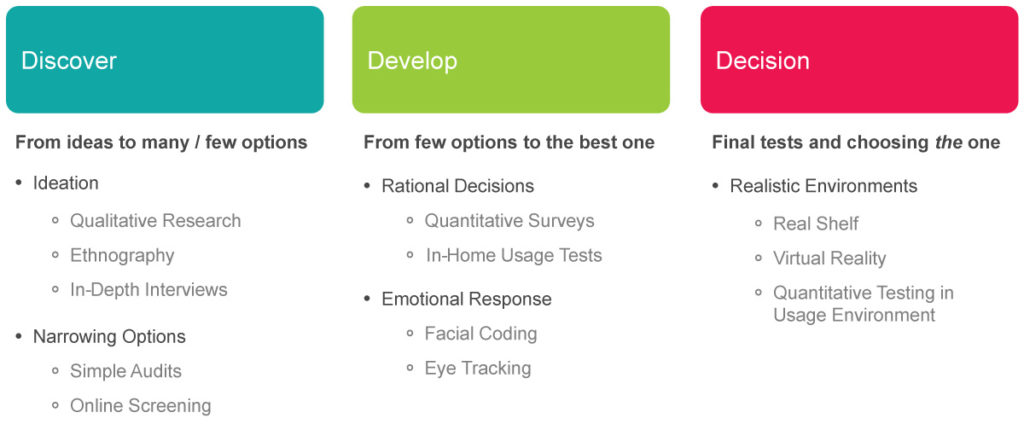Chapter 3:
Technology is Enabling Better Package Design Research
While package design research isn’t a new idea to companies, how they approach and apply it has changed significantly.
Advances in technology and a better understanding of behavioral science based research have resulted in far more accurate market research tools across all Market Research, and packaging research is no exception to this.
Today’s challenging market environment and business demands require richer insights to gain a competitive edge and achieve desired growth. Thus, companies are turning to research experts whose techniques will provide deeper insight into decision making, including subconscious drivers that are better predictors of actual behavior.
Thought leaders in market research are adopting and investing in building expertise in these more advanced market research techniques including eye tracking and virtual reality. Their goal is to provide companies with the best insights possible for improved decision making.
The Right Package Design Research Technique at the Right Time
There are a variety of research tools available depending on what you need to understand and the decisions you need to make.
The specific technique used is based on whether you are in the early development stage of packaging design, the optimization stage or the in-market assessment of final options.


Discover
Begin with Qualitative research, Ethnography and In-Depth Interviews, to gain a deeper understanding of the category, consumer and shopper. Identify unmet needs or issues with existing or competitive packaging to understand opportunities. Simple audits of the store conditions and competitive packages are also helpful input at this stage.
Look at assessing existing structures in the marketplace as well as competitive designs. At the discovery phase it is important to also have the context of the shelf to understand the amount of complexity in the category.
The discovery phase can often help inform the design brief with insights that can help direct design.

Develop
Your Packaging Company will design a range of packaging options based on insights to date. The research objective now is to gain preliminary feedback and narrow down options and efficiently screen these down using on-line screening or quali-quant techniques. With a fewer number of packaging options, move directly into the final validation stage.
At this stage, the goal is to improve packaging elements before final “in-market” testing. This includes elements involved in both rational and emotional decision making.
Rational decisions often include functional design aspects. These can be tested using more traditional research techniques such quantitative surveys or in-home usage tests. These include understanding communication elements such as benefits or desired imagery. Also included are usage elements, such as clarity of product instructions or ease of opening.
Understanding and optimizing the emotional response to your package requires more advanced research techniques. These are elements of the package that influence non-conscious behavior, that is, factors in the decision making process which consumers are not aware of and unable to accurately describe.
Another technique, Eye Tracking, shows what elements of the package are noticed and in what order. This includes colors, symbols, and words and can help increase likelihood of effective communication of all important benefits, as well as Branding and Sub-branding. When conducted in a shelf environment, which is recommended, Eye Tracking will also assess breakthrough.
Decision
This is the stage that will identify the packaging option to move forward with. Quantitative techniques done in realistic environments are critical at this stage to best assess in market performance of the package design.
Virtual reality or real shelf environment testing are best for accurately measuring effect on purchase. This is the only way the shopper can realistically experience your package and identify which one is most likely to be chosen. These methods take into consideration the competitive set, shopper distractions, time restrictions and other real life shopping impacts.
Quantitative testing in the usage environment is best for determining packaging designs that could increase repeat purchase. Cap size on laundry detergent or where your product is stored in the fridge for increased visibility will increase usage frequency.
Your business goals and research objectives will ultimately guide which are the best research approaches. The most successful outcome typically combines a blend of techniques to provide a complete picture.
Done right, you will ensure your package is working as hard as possible to increase sales!
In Chapter 4 we discuss common mistakes in product package design research and how to do it right.

